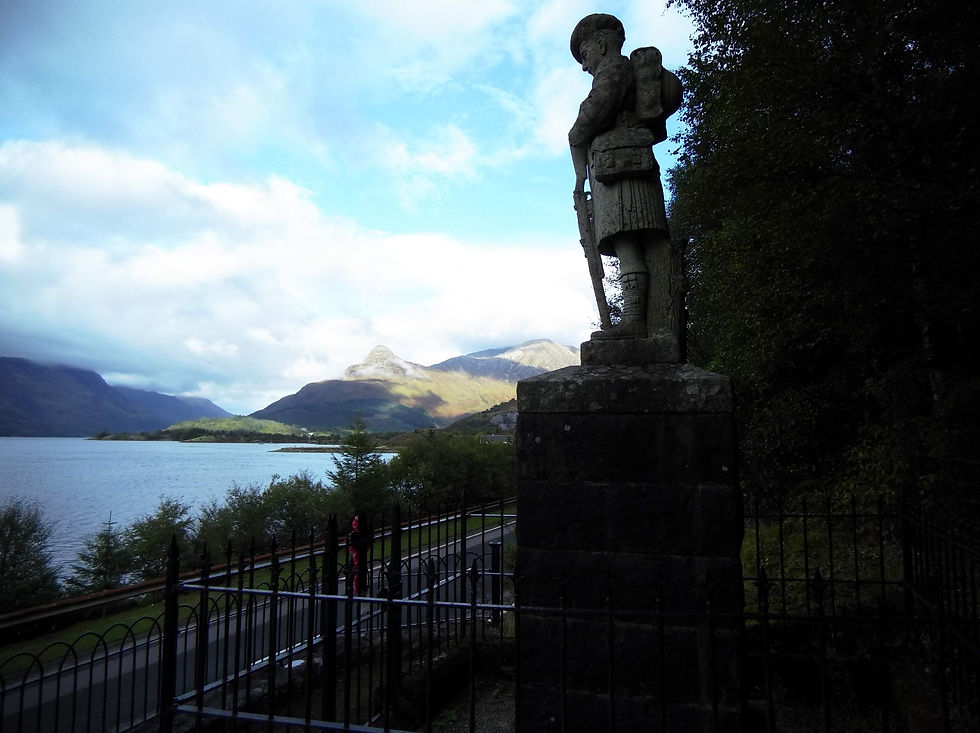Military History & Travel: WW1 Memorial for the fallen of Balluchulish & Glen Coe, Glen Coe Scotland
- Ryan Weston
- Apr 1, 2020
- 3 min read

Alright. Admittedly this is going to be a quick post, but a meaningful one for me nonetheless. Have you ever had the opportunity to explore Glen Coe in the Scottish Highlands? If not I highly recommend that you do so, provided of course that you enjoy challenging hiking. I could wax poetic for hours about the savage beauty, the dark history, and the solitude you’ll experience exploring there. But that’s not what this post is about. This post is about getting there, or more specifically, about driving there from Inverness and coming up the A82 and seeing this beautiful war memorial on my way in.
As is the case (from my experience) of many things in Scotland, this memorial came up unannounced and without signage and offered very little time or space to pull the car over to park and get out to explore. Making note of its location, we chose to stop on the way back after hiking for the day in Glen Coe. Tired and mud-spattered as we were I wanted to take some time to pay my respects and to experience as much of it in as I could. Which as it turns out was only a fraction, as the memorial itself is adjacent to a church and a Commonwealth War Graves cemetery, and unfortunately the iron gates that lead into the cemetery itself were closed upon our arrival. As it was, the time I had with the memorial and its surroundings were still a sobering and entirely worthwhile experience.
The memorial itself is a stone statue of a soldier of the Great War in Highland uniform, who stands upon a large stone base which is engraved with the names of the fallen from the region. That in itself is I suppose not entirely unique as far as memorials go, but it is the setting and the thoughts that it evokes that really grabs hold of you and makes you sit still and quiet for a spell. Having just hiked Glen Coe all day, my wife and I had seen, outside of sparse traffic on the roads, perhaps less than ten people. And we were there for hours. And it was 2018. We had spent the better part of our day in what is an international tourist attraction in 2018 and had seen hardly a soul. How much more alone would we have been if it would have been 1918 instead? That’s what hit me the hardest. Not only was this possibly the loneliest war memorial that I had ever encountered, but what’s more, the losses that it represented must have been truly devastating all out of proportion to the actual numbers.
The loss of these brave men must have been so keenly felt in such a sparsely populated region, and surely left huge gaps in both families and communities alike. So very far from home these men were, at a time when getting to where they were was such an arduous task. How incredibly difficult it must have been just to bring word to the local families of the fallen, as isolated as they were from the rest of the world in 1918. How incredibly sad this entire region must have been as repeated messengers brought their repeated dreadful news.
How incredibly sad this memorial is, 100 years later.
It is very hard to quantify the costs of war, and it is easy to become benumbed by statistics- especially when discussing the Great War. Sometimes it takes a sea of white crosses for it to hit home. Other times, it just takes one lonely soldier, forever standing his post on the side of the road.
Lest we forget.
R. E. Weston





Comments